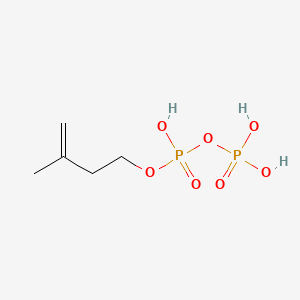| MeSH term | MeSH ID | Detail |
|---|---|---|
| Melanoma | D008545 | 69 associated lipids |
Isopentenyl pyrophosphate
Isopentenyl pyrophosphate is a lipid of Prenol Lipids (PR) class. Isopentenyl pyrophosphate is associated with abnormalities such as Tuberculosis, NAVAJO NEUROHEPATOPATHY and Cryptosporidiosis. The involved functions are known as Signal, Anabolism, T-Cell Activation, T-Cell Proliferation and isoprenoid biosynthetic process. Isopentenyl pyrophosphate often locates in Protoplasm, Host Cell, soluble, Plastids and Cell surface. The associated genes with Isopentenyl pyrophosphate are oxytocin, 1-desamino-(O-Et-Tyr)(2)-, HLA-E gene, RAP1A gene, Gene Family and Orthologous Gene. The related lipids are Steroids, Sterols and isopentenol.
Cross Reference
Introduction
To understand associated biological information of Isopentenyl pyrophosphate, we collected biological information of abnormalities, associated pathways, cellular/molecular locations, biological functions, related genes/proteins, lipids and common seen animal/experimental models with organized paragraphs from literatures.
What diseases are associated with Isopentenyl pyrophosphate?
Isopentenyl pyrophosphate is suspected in Tuberculosis, NAVAJO NEUROHEPATOPATHY, Cryptosporidiosis and other diseases in descending order of the highest number of associated sentences.
Related references are mostly published in these journals:
| Disease | Cross reference | Weighted score | Related literature |
|---|
Possible diseases from mapped MeSH terms on references
We collected disease MeSH terms mapped to the references associated with Isopentenyl pyrophosphate
PubChem Associated disorders and diseases
What pathways are associated with Isopentenyl pyrophosphate
Lipid pathways are not clear in current pathway databases. We organized associated pathways with Isopentenyl pyrophosphate through full-text articles, including metabolic pathways or pathways of biological mechanisms.
Related references are published most in these journals:
| Pathway name | Related literatures |
|---|
PubChem Biomolecular Interactions and Pathways
Link to PubChem Biomolecular Interactions and PathwaysWhat cellular locations are associated with Isopentenyl pyrophosphate?
Visualization in cellular structure
Associated locations are in red color. Not associated locations are in black.
Related references are published most in these journals:
| Location | Cross reference | Weighted score | Related literatures |
|---|
What functions are associated with Isopentenyl pyrophosphate?
Related references are published most in these journals:
| Function | Cross reference | Weighted score | Related literatures |
|---|
What lipids are associated with Isopentenyl pyrophosphate?
Related references are published most in these journals:
| Lipid concept | Cross reference | Weighted score | Related literatures |
|---|
What genes are associated with Isopentenyl pyrophosphate?
Related references are published most in these journals:
| Gene | Cross reference | Weighted score | Related literatures |
|---|
What common seen animal models are associated with Isopentenyl pyrophosphate?
There are no associated biomedical information in the current reference collection.
NCBI Entrez Crosslinks
All references with Isopentenyl pyrophosphate
Download all related citations| Authors | Title | Published | Journal | PubMed Link |
|---|---|---|---|---|
| Lei A et al. | Expression of fatty acid synthesis genes and fatty acid accumulation in haematococcus pluvialis under different stressors. | 2012 | Biotechnol Biofuels | pmid:22448811 |
| Wang YD et al. | Inhibitor studies of isopentenyl pyrophosphate biosynthesis in suspension cultures of the yew Taxus chinensis var. mairei. | 2003 | Biotechnol. Appl. Biochem. | pmid:12578550 |
| Wang C et al. | Farnesol production from Escherichia coli by harnessing the exogenous mevalonate pathway. | 2010 | Biotechnol. Bioeng. | pmid:20552672 |
| Souret FF et al. | Scale-up of Artemisia annua L. hairy root cultures produces complex patterns of terpenoid gene expression. | 2003 | Biotechnol. Bioeng. | pmid:12889030 |
| Sutherlin A and Rodwell VW | Multienzyme mevalonate pathway bioreactor. | 2004 | Biotechnol. Bioeng. | pmid:15286992 |
| Kang MJ et al. | Identification of genes affecting lycopene accumulation in Escherichia coli using a shot-gun method. | 2005 | Biotechnol. Bioeng. | pmid:15898075 |
| Yoon SH et al. | Enhanced lycopene production in Escherichia coli engineered to synthesize isopentenyl diphosphate and dimethylallyl diphosphate from mevalonate. | 2006 | Biotechnol. Bioeng. | pmid:16547999 |
| Kim SW and Keasling JD | Metabolic engineering of the nonmevalonate isopentenyl diphosphate synthesis pathway in Escherichia coli enhances lycopene production. | 2001 | Biotechnol. Bioeng. | pmid:11180061 |
| Bartoszewska M et al. | The significance of peroxisomes in secondary metabolite biosynthesis in filamentous fungi. | 2011 | Biotechnol. Lett. | pmid:21660569 |
| Hong SB et al. | Role of the non-mevalonate pathway in indole alkaloid production by Catharanthus roseus hairy roots. | 2003 May-Jun | Biotechnol. Prog. | pmid:12790690 |
| Srinivasan V et al. | Metabolic inhibitors, elicitors, and precursors as tools for probing yield limitation in taxane production by Taxus chinensis cell cultures. | 1996 Jul-Aug | Biotechnol. Prog. | pmid:8987474 |
| Yoon SH et al. | Increased beta-carotene production in recombinant Escherichia coli harboring an engineered isoprenoid precursor pathway with mevalonate addition. | 2007 May-Jun | Biotechnol. Prog. | pmid:17500531 |
| Vadali RV et al. | Enhanced lycopene productivity by manipulation of carbon flow to isopentenyl diphosphate in Escherichia coli. | 2005 Sep-Oct | Biotechnol. Prog. | pmid:16209562 |
| Cipriani B et al. | Activation of C-C beta-chemokines in human peripheral blood gammadelta T cells by isopentenyl pyrophosphate and regulation by cytokines. | 2000 | Blood | pmid:10607682 |
| Maniar A et al. | Human gammadelta T lymphocytes induce robust NK cell-mediated antitumor cytotoxicity through CD137 engagement. | 2010 | Blood | pmid:20519625 |
| Thompson K et al. | Alkylamines cause Vgamma9Vdelta2 T-cell activation and proliferation by inhibiting the mevalonate pathway. | 2006 | Blood | pmid:16179378 |
| Schmidt T et al. | Characterization of rubber particles and rubber chain elongation in Taraxacum koksaghyz. | 2010 | BMC Biochem. | pmid:20170509 |
| Sangar V et al. | Quantitative sequence-function relationships in proteins based on gene ontology. | 2007 | BMC Bioinformatics | pmid:17686158 |
| Hawari AH and Mohamed-Hussein ZA | Simulation of a Petri net-based model of the terpenoid biosynthesis pathway. | 2010 | BMC Bioinformatics | pmid:20144236 |
| Elmore ZC et al. | Sumo-dependent substrate targeting of the SUMO protease Ulp1. | 2011 | BMC Biol. | pmid:22034919 |
